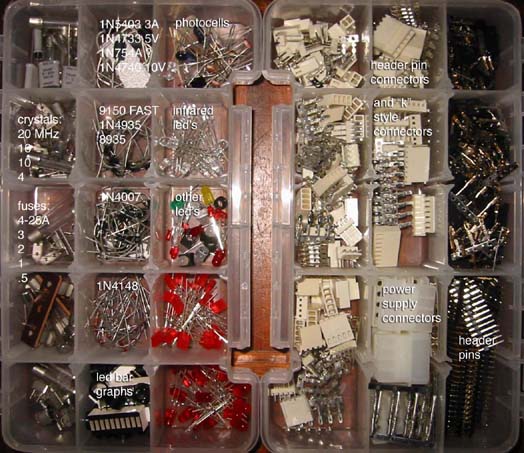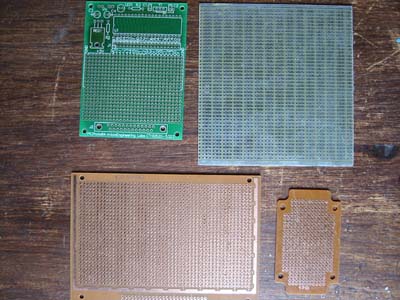
common ingredients
These are the some basic parts you’ll need to get started with electronics.
What parts to buy? That's a good question! “Buy only the parts you need” is not the best answer, because you're never quite sure what you might need. If you’re lucky, you live close to a good electronics store, or have a mail order place that doesn't charge too much.

You can also order from DigiKey in Europe, but the shipping is expensive. In Germany, Reichelt is a mail-order company with excellent prices.
International suppliers Future/Active, and Farnell in Europe are ok, but I find them often (but not always) overpriced and difficult to deal with. Conrad in Germany (and mail-order in the rest of Europe) have a pretty good selection, but again overpriced and under-stocked compared to DigiKey.
There are two places in Amsterdam, MUCO/Display Electronics, and Radio Rotor (both in the Kinkerstraat/Bilderdijk area) where you can buy most of the things you might need. Prices and selection are not great, but at least they're convenient. In Brussels, there is Elak, which seems to have better selection and prices than Amsterdam. For PIC chips and certain other items, try Wouter's site at voti.nl. Other than that, I don't know - please tell me if you know of any good sources for parts! Hunting and gathering seems to be a big part of the art of electronics...
Below are pictures of the collection of parts that I thought were imporant enough to take with me on my travels. I can't really tell you exactly what parts you need or don't need, it depends on what you want to build. I have many more parts at home. But too often I just don't have that one part that I need! One way to organize your components is to use plastic boxes with small compartments. For really small ones like resistors, you want to find boxes that have ribs on the lids so the parts don't jump their compartments when you put them in your suitcase...

Resistors and Capacitors
Sorry this picture is not the easiest to understand, I made it so I could remember what was in my boxes.
Resistors - one of the fundamental components. Generally bought in the "carbon resistor (Kohleschicht-Widerstände), 1/4 watt, 5% tolerance" type, and measured in ohms. Relatively inexpensive. You definitely need a few (ten or more) of each the following values:
220 ohms, 1k ohms, 4.7k ohms, 10k ohms, 100k ohms ("k" means 1000).
The above values will equip you to deal with only the most basic of analog circuits, but will cover a lot of the digital stuff. Otherwise, get some of all the values listed in the photo. Or whatever you like; if you have a particular schematic diagram of something, it will list the sizes you need. If you want to splurge, buy a prepackaged assortment of all the common values.
Capacitors - another fundamental component, and comes in an even more bewildering array of sizes and types.
You will need some 22pF ceramic disc capacitors if you want to work with microcontroller chips that use crystal clocks. You might want to get some ceramic disc capacitors in small sizes, eg. marked as 101, 102, and 103, and 104. "Mono Ceramics" in sizes 103 and especially 104 are very important in digital circuits, and sometimes Tantalum at 1uF. Above those sizes you will get into Mylar capacitors, up to about 1uF or more. They are more used in analog circuits. For the larger sizes, 1uF to 1000uF or more, electrolytics are used mostly for filtering. Definitely get some 10uF, 100uF, and 1000uF electrolytics, rated for at least 10 to 25 volts for the larger ones that are used as power supply filters. Sorry again, I could go into a lot more detail about capacitor selection, but it would go on for pages and pages....

Voltage Regulators, Transistors, OpAmps, Sockets, Pots, and Connectors
Let's see what we've got here...
7805/78L05 - 5-volt regulators in large and small current types. Just get one or two 7805's.
2N3904 - small signal transistors. Get five or ten of these.
ULN2803 - eight transistors on a chip, very handy for driving small motors and things. Try to get at least one.
IRL510 - a big transistor. If you want to make giant robots, you need giant motors and giant transistors. This is one. There are many others.
Relays - used to switch really big things on and off. Also good for giant robots.
Pushbuttons and various kinds of switches - as you like.
DIP sockets - for putting chips into, so you don't break them whilst soldering. Not needed if you will only use solderless breadboards. Size depends on what chips you need.
Potentiometers - a.k.a. "volume controls" or knobs. Used in many circuits, also as sensors. Depends on your circuit. For sensors, get 10k Linear pots.
OpAmps - analog amplifier chips - various types for various uses. TL072 and LM358 are generally useful ones.
Connectors - whatever you like, but popular ones are:
DB9 - computer serial connectors, usually you need the female ones.
MIDI or DIN-5 - for MIDI stuff
Stereo mini - for headphones etc.
DC plugs & jacks - definitely get at least one, see "power supply" section of utensils page.
Screw Terminals - probably essential if you build your own circuit boards; for attaching wires, power, sensors, etc.
RCA/cinch - usually for sound and video connections
9-volt battery clip - definitely get a couple of these.

Diodes, Optical, and Header Connectors
For PIC, Atmel AVR, and other microcontrollers, you may need crystals. I often use 20MHz, or 16MHz for Arduino-compatible circuits.
Fuses are always good to add to a circuit for safety. Really!
Diodes are one more fundamental component. 1N4148, and 1N4001 (or 1N4007 if you find it) are mostly what you'll need.
Photocells (Light Dependent Resistors) are useful - although overused - sensors.
L.E.D.'s are small light bulbs that everyone loves a lot. Get some.
The rest are "header pin" connectors, small rows of pins that are used on circuit boards to connect things. It's easy to ignore these, but in my experience, it's the connectors that always give the most problems and cause the most failures.
Cool Chips
Well, I don't even have pictures.
Digital: There is a whole series of digital logic chips, the 7400 series, plus another 4000 series. These contain "logic gates", AND/OR/NOT, and so on. A little hard to explain here. Get some inverter chips for a start, if you want to have some around. Otherwise, again, it's pages and pages...
Analog: Already mentioned OpAmps. And there are tons more. Read the catalogs, search the web. Find schematics...
Microcontrollers:
Basic Stamp. You can see one on the small solderless breadboard photo on the other page. Pros: relatively easy to program, on Macintosh, PC, or Linux. Cons: expensive, slow, not very powerful.
PIC chips. Pros: WAY cheaper, much faster and more capable. Cons: more difficult to program, generally requires Windows computer. Pro or Con?: a bewildering array of models/part numbers available. I recommend looking at (in order): 16F877, 18F452, 16F676, 16F628A - may be others, depends on your needs.
Atmel AVR chips - similar to PICs. Pros: can be programmed in C with the gnu compiler. Cons: not quite as many options as the PIC chips. I recommend the Atmega8 or Atmega168, which the Arduino is based on.
Guess I really should try to expand this section in the future. But there are really so many chips available, just to list their names, let alone describe how they work. Read the catalogs, books, search the web... and most importantly, find schematics of projects that other people have already made. Learn from there...

Once you get a circuit working on a solderless breadboard, you might want to transfer it to something more permanent. One choice is to use a generic blank printed circuit board, that you solder the components into.
There are many different styles, and the choice is your own. I like the "sea of holes" style shown in the bottom two examples, but sometimes the "three holes per pad" is nice, or, if you can afford it, one made especially for PIC chips (top left). Another popular one, not shown, is long strips of copper that you cut where needed, using a special tool. There are even some that are laid out in the same way as a solderless breadboard, to ease the process of transferring over. One word of caution: you might not think so, but creating a circuit on one of these boards is massively more work than creating the same circuit on a solderless breadboard. At least that's my experience. So if you can leave your circuit on the breadboard, do so. But if you plan to ship it across the ocean or something, you'd better solder it into one of these boards, or the parts will fall out!
The other option is to design and/or etch your own printed circuit boards. But that's another page.
Have fun...